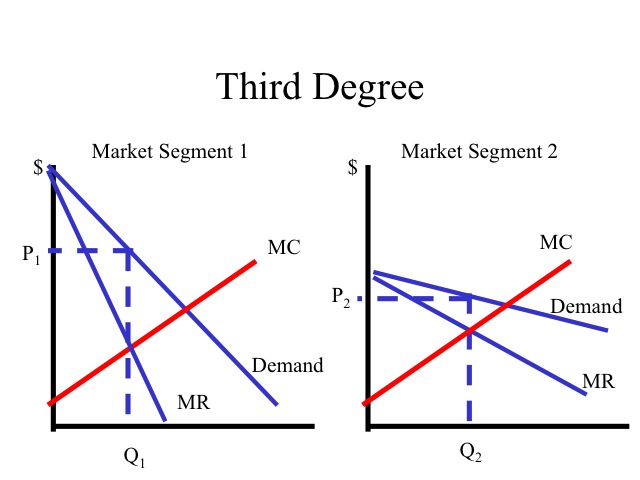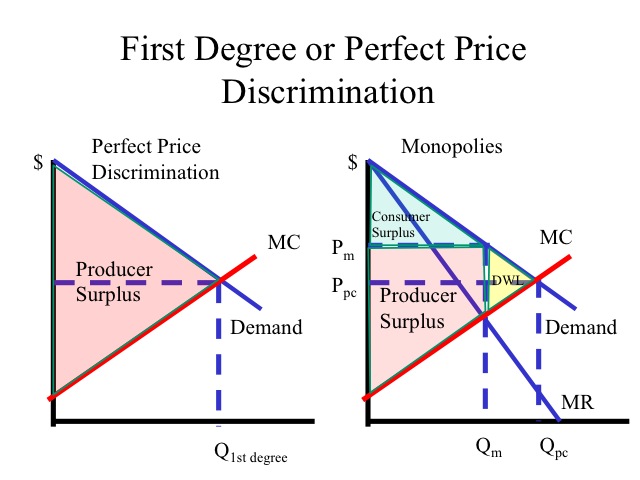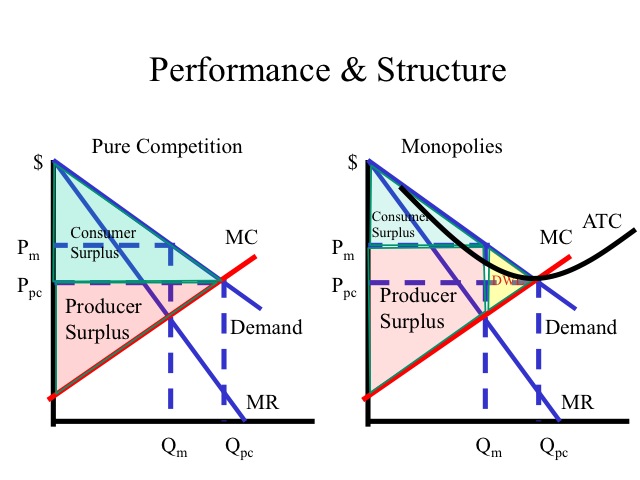A PERFECT PRICE DISCRIMINATOR
A perfect price discriminator A is unable to make an economic profit. Buyers are unlikely to reveal their willingness to pay.

Chapter 16 Pricing Strategy Flashcards Quizlet
A perfect price discriminator A.
. A charges the maximum price for each unit that consumers are willing to pay. A perfect price discriminator If a market is controlled by one perfect price discriminator who is able to charge each consumer the highest price that consumer is willing to pay the seller will produce output until the price paid by the last consumer is equal to. See the following diagram.
First-degree or perfect price discrimination involves the seller charging a different price for each unit of the good in such a way that the price charged for each unit is equal to the maximum willingness to pay for that unit. C is unable to make an economic profit. The value of deadweight loss for a perfect price discriminator is _____ an imperfect price discriminator.
Perfect price discrimination also called pure price discrimination is an economy theory where a business is able to charge the maximum price that consumers are willing to pay for each of its products leaving no consumer surplus. D disregards the market demand curve. B is able to convince consumers to pay more for each unit than they are willing to pay.
Perfect price discrimination d. - this is when a monopoly charges a single price to all its consumers. A greater than b the same as c.
This eliminates consumer surplus and turns that into revenue which in turn increases the economic profits that are earned by the firm. Ad Build your Career in Data Science Web Development Marketing More. Flexible Online Learning at Your Own Pace.
Zero c imperfect price discrimination. A perfect price discriminator sets the price of each unit sold equal to the reservation price of the good. Invest 2-3 Hours A Week Advance Your Career.
A firm that is a perfect price discriminator is best described as. 2 days agoFirst degree price discrimination is also known as perfect price discrimination and this perfection makes it difficult to implement in practice. Because prices vary among units the firm captures.
The business will then keep all of the consumer surplus or economic surplus. A firm has two customers. B disregards the market demand curve.
Nevertheless it involves the business charging the maximum price consumers are willing to pay for each unit of product or service sold. First-Degree Price Discrimination. Charges lower prices to customers who buy greater quantities.
Economics questions and answers. First-degree discrimination or perfect price discrimination occurs when a business charges the maximum possible price for each unit consumed. The logic of price discrimination.
Perfect price discrimination is almost never possible. Charges different prices to each customer based upon different costs of delivery. Less than the marginal revenue for a non-discriminating.
A Some who can find the best price b Someone with prejudice c A firm that charges each customer exactly his. Thus the price of each unit will equal the marginal revenue of each unit. A pure monopoly charges a single price where a price discriminator will charge each consumer at different prices.
The firm is able to charge the maximum possible price for each unit which enables the firm to capture all available consumer surplus for itself. In this type of price discrimination a company will charge as much as possible for each unit they sell. O equal to the price paid for each unit of output 0 0 the same as the marginal revenue curve if the firm is a non-discriminating monopolist.
First-degree discrimination or perfect price discrimination occurs when a business charges the maximum possible price for each unit consumed. On the other hand total revenue TR of single-pricing sellers assumes an inverted U shape. First-degree price discrimination is also called perfect price discrimination.
A perfect price discriminator. A firm would have to know the maximum amount each buyer is willing to pay for each unit. What is perfect price discrimination.
D is able to convince consumers to pay more for each unit than they are willing to pay. By price discriminating a monopolistic firm will increase its economic profits. First-degree price discrimination alternatively known as perfect price discrimination occurs when a firm charges a different price for every unit consumed.
Generates a deadweight loss to. For a perfect first-degree price discriminator marginal revenue is. Very high d imperfect price discrimination.
Solution for For the Perfect Price Discriminator 1st Degree Price Discriminator the demand curve is also the marginal revenue curve. - students are willing to pay a lower price. C charges the maximum price for each unit that consumers are willing to pay.
Because prices vary among units the firm captures all available consumer surplus for itself or the economic surplus. Perfect price discrimination results in continuously rising total revenue TWP until price goes down to zero. Charges each buyer her reservation price.
This results in prices that vary among the items sold. The price equals the maximum price a consumer will pay for a given unit. We can call the perfect price discriminators TR the total willingness to pay TWP and the buyers reservation price the marginal willingness to pay MWP.
0 o greater than price if the demand curve is downward sloping.
Economics In Plain English Price Discrimination 101
![]()
Monopoly Ii First Degree Price Discrimination Policonomics

Microeconomics Block Pricing Vs Perfect Price Discrimination Economics Stack Exchange






0 Response to "A PERFECT PRICE DISCRIMINATOR"
Post a Comment